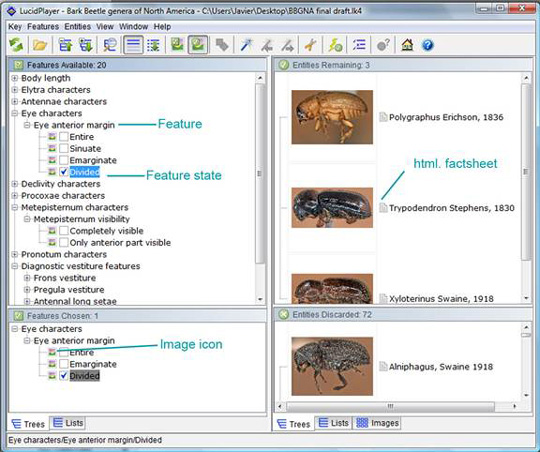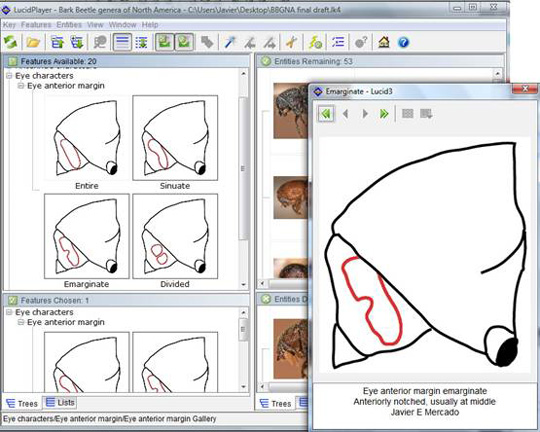The Lucid key has four panels. Each feature in the Features Available panel is listed above two or more of its states (also referred to as feature states). For example, "entire" and "divided" are two states of the feature "Eye anterior margin." State illustrations are indicated by icons or thumbnails, depending on the display options you choose under Features > Display. Each state is shown alongside the state illustration or icon. Once you choose a state, it will appear in the lower left Features Chosen panel. The taxa that match the chosen features are displayed in the upper right Entities Remaining panel, while those that do not will be moved to the Entities Discarded panel in the lower right corner.

Each genus in Entities Remaining (possible genera) is linked to a fact sheet page containing informational text and images. This page is indicated by a grey icon to the right of the image or image icon. Each genus is also linked directly to a lateral view image of that entity. Images for each genus are indicated by icons or thumbnails, depending on the display options you choose.

First, go to the Is it a bark beetle? page. This page shows how to confirm your specimen is a bark beetle using simple characters. Once you know that your specimen is a bark beetle, you can proceed to the key.
You can begin with any feature (upper left panel), though it is recommended that you start with the "elytral anterior margin shape" feature (found under "Elytra characters") since this will separate the subfamily into its two major subdivisions, the tribes Hylesinini and Scolytini.
A good way of proceeding into the key is to select what you believe is a strong character in your subject. You may also choose to use Lucid's "Best" feature, which will take you to the feature that will most effectively reduce the number of entities remaining. To use "Best," select the "magic wand" icon in the menu bar. Generally, the features are organized (top to bottom) so those that apply most broadly, separating the 75 genera into larger groups, appear at the top of the features panel, and those features that apply to more specific, and therefore smaller, groups appear near the bottom of the features panel. The only exception to this is the size feature, which doesn't necessarily follow this scheme. The great majority of the feature descriptions are based on the North and Central American species from Wood (1982).
For convenience, technical terms used in this tool are defined in the glossary; however, you may find it worthwhile to familiarize yourself with general morphological features such as declivitydeclivity:
the apical portion of the beetle elytra that slopes downward
, metepisternummetepisternum:
the sclerite between the first and second lateral thoracic sutures
, antennal clubclub:
the apical segment of the insect antennae that is enlarged or thickened such that it is anatomically differentiated from the preceding segments
, and so on, prior to starting the key. Understanding these terms will allow you to navigate more effortlessly though the identification of a specimen.
Drawings used to illustrate the feature states were adapted from illustrations of particular species or are diagrammatic. They are intended to represent a range in appearance and are meant to be used as examples. In choosing a state, your specimen does not need to exactly match the state's illustration. Rather, choose the state to which your specimen looks the most similar.
Photographed species for each genus were chosen based on one or more of the following criteria: 1) the type species, 2) a species occurring in Colorado and available at local museums, 3) a pest species, or 4) one that simply was readily available for imaging. Please note that the images provided do not necessarily reflect all known morphological variation within the genus, and a number of genera within the Scolytinae are quite similar in appearance. Every diagnosis should be confirmed by carefully reviewing the information provided on the fact sheet. In the key, entity images are lateral views, but additional views are available on the fact sheets.
A summary of each genus is provided by clicking on the fact sheet icon next to the genus name.
The following sections are included in each factsheet:
Diagnosis: offers useful characters to separate the genus from other similar genera which may or may not be closely related.
Description: descriptions provided are based on several literature sources (primarily Wood 1982), personal observations, as well as communication with colleagues and specialists. They are diagnostic of most species within a given genus. Descriptions are presented in a way that provides the user with general traits that are applicable for a particular genus but may or may not reflect all morphological variation within the genus.
Distribution: the general distribution given represents the geographical areas where members of the genus are known to occur.
World fauna: the numbers provided in this section are derived from multiple sources and are estimates of the total diversity of that genus, worldwide and within the scoped region.
Exotic species: the exotics species which are currently established in the United States and which states they are known to be present in as of 2010.
Hosts: a list of the known hosts for any particular genus.